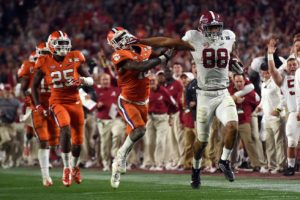As I have done for the last few years, this week I will be using the raw NFL combine data and adjusting them various metrics. With respect to the 40-yard dash, the only adjustment I’ve made is for weight, as no other variable (e.g., height) impacts a player’s 40 time quite like weight. The best-fit formula to predict 40-yard dash time during the 2017 combine was 3.283 + 0.00606 x weight. ((This time around, I excluded punters, kickers, and long snappers when running regressions, as those players aren’t invited to their combine for their raw athleticism (and removing them made the numbers a little tighter). As you can see
Let’s use Alabama tight end O.J. Howard as an example. He weighed 251 pounds at the combine, which means he would be projected to run the 40-yard dash in 4.81 seconds. Instead, he ran it in just 4.51 seconds, a full 0.30 better than expected.
That was the best performance of any player at the combine. A very close second was produced by the presumptive number one pick in the draft, Myles Garrett. The Texas A&M defensive end weighed 272 pounds, so using the formula above, a player of Garrett’s size should run the 40 in 4.93 seconds. But Garrett was 0.29 seconds better than expected, completing the drill in 4.64 seconds. Garrett reportedly bested that time by running 40 yards in 4.57 seconds at his Pro Day, too.
Some other notes: Leonard Fournette ran the best weight-adjusted 40 for all running backs, while WR John Ross had the best weight-adjusted 40 time for receivers. Ross, of course, ran the 40 in a record 4.22 seconds, but he also weighed in at only 188 pounds. By comparison, Garrett was 84 pounds heavier and took “only” 0.42 more seconds. That’s 2 pounds of additional weight he was carrying for every hundredth of a second, while the regression says that 1.65 pounds of weight should cost an extra 0.01 seconds.

